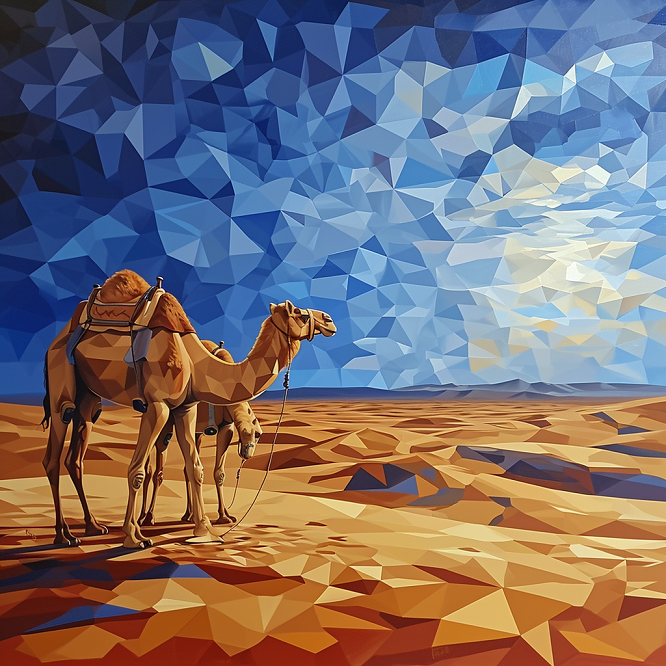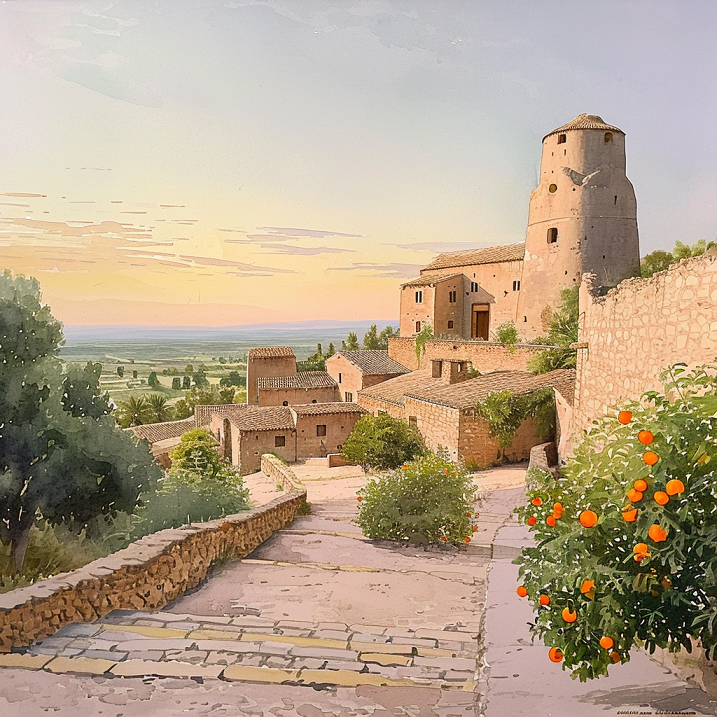Lady Anne Blunt’s journey, as recounted in “A Pilgrimage To Nejd,” is punctuated by a gripping episode of adventure and conflict that vividly illustrates the unpredictable and often perilous nature of travel in the Arabian desert.
The day begins with a typical early start, but the group is soon caught in a dramatic and unforeseen encounter. While momentarily separated from their caravan, Lady Blunt and her husband Wilfrid find themselves the targets of a surprise attack by horsemen. The suddenness and intensity of the attack, with horsemen charging at full gallop, armed with lances, thrusts the travellers into a situation of immediate danger and chaos. The description of the assault, with its vivid imagery and fast-paced narrative, conveys the shock and urgency of the moment,
In a desperate bid for safety, Lady Blunt and Wilfrid attempt to mount their mares, but Lady Blunt’s sprained knee and the deep sand impede her efforts. The attackers are upon them before they can escape, and a violent struggle ensues. Wilfrid, armed but outnumbered, faces his assailants with bravery, but the situation appears dire.
The turning point in this harrowing episode comes when Lady Blunt, realising the futility of resistance, surrenders to the attackers, uttering the traditional plea for protection: “ana dakhilak” (I am under your protection). This act of surrender, adhering to the cultural norms and customs of the desert, marks a critical moment in the confrontation.
Wilfrid, upon hearing Lady Blunt’s surrender, also ceases his resistance, throwing himself off his mare. This decision, born out of necessity, reflects the travellers’ quick thinking and adaptability in the face of danger. The confrontation then shifts from physical to verbal, as the attackers and the travellers engage in a tense dialogue to ascertain each other’s identities and intentions.
Wilfrid jumped to his feet, looked round and called out, ” Get on your mare. This is a ghazu. (raid)” As I scrambled round the bush to my mare I saw a troop of horsemen charging down at full gallop with their lances, not two hundred yards off.
There was no time to think and I had hardly struggled to my feet, when the enemy was upon us, and I was knocked down by a spear. Then they all turned on Wilfrid, who had waited for me, some of them jumping down on foot to get hold of his mare’s halter.
He fortunately had on very thick clothes, two abbas one over the other, and English clothes underneath, so the lances did him no harm. At last his assailants managed to get his gun from him and broke it over his head, hitting him three times and smashing the stock.
Lady Anne Blunt: A Pilgrimage to Nejd, The Cradle of the Arab Race
The resolution of the conflict is as sudden as its onset. Once the attackers learn that Lady Blunt and Wilfrid are English travellers accompanied by Mohammed ibn Aruk of Tudmur and under the protection of Ibn Shaalan, the mood changes dramatically. The attackers, who are revealed to be from the Ruwalla tribe and under the protection of Ibn Shaalan, recognize their obligation to safeguard the travellers rather than harm them. This twist highlights the complex web of allegiances and protections that govern interactions in the desert.
The restoration of peace is marked by the return of the travellers’ possessions, including their mares and Wilfrid’s gun. The interactions that follow, with the attackers expressing regret for their actions and the two groups sharing dates and the pipe of peace, illustrate the fluidity of relationships in the desert, where enemies can quickly become guests under the right circumstances.
Continuing the Journey to Jawf
As Lady Anne Blunt’s expedition to Jawf progresses, the narrative in “A Pilgrimage To Nejd” continues to unfold with a blend of anticipation and the stark realities of desert travel. This section, covering the journey after the harrowing encounter with the Ruwalla horsemen, reflects the resilience and adaptability necessary for survival in such an unforgiving landscape.
The travellers recommence their journey on January 2, 1879, amidst challenging conditions, including a hard frost that leaves water frozen in the pails. Despite these adversities, they reach the wells of Shaybeh, a critical resource in the desert. Here, the water’s brackish nature serves as a reminder of the harshness of the environment. Yet, the ability to find and utilize such resources underscores the travellers’ ingenuity and determination.
As they journey onwards, the group encounters various landmarks that add texture to the narrative. They pass a curious rock formation initially mistaken for a castle, a testament to the intriguing and often deceptive nature of the desert landscape. The mention of the ruined house of Abu Kasr and another well near it further enriches the reader’s understanding of the region’s history and the remnants of past civilisations that dot the landscape.
The narrative then shifts to a personal concern: Wilfrid’s recovery from a severe cold and Lady Blunt’s ongoing struggle with lameness. These personal ailments highlight the physical toll of the journey and the vulnerability of the travellers in the face of the desert’s harshness. Yet, their determination to continue, despite these challenges, speaks volumes about their character and the compelling nature of their quest.
More Encounters and Observations
Lady Anne Blunt’s experiences, ranging from encounters with locals to observations of the natural landscape, add depth and colour to the narrative, showcasing the diversity of experiences in the Arabian desert.
One of the most striking features of this part of the journey is the encounter with two men on a camel. This meeting is significant as it breaks the monotony of their journey and provides a rare interaction with other people in the vast desert. The men, on a mission to find a lost man from Ibn Rashid’s party, embody the challenges of desert life, where survival often hangs in a delicate balance. The exchange of dates and water skins between Wilfrid and the men is a moment of human connection in the otherwise isolated expanse of the desert.

The journey progresses through a landscape marked by red, yellow, and purple sandstone, reminiscent of the Sinai peninsula’s terrain. This observation not only adds to the visual imagery of the narrative but also links the Arabian landscape to other well-known desert regions, highlighting the vast and varied nature of desert geographies.
In addition to the natural landscape, Lady Blunt’s interactions with Hamdan about his tribe, the Sherarat, provide valuable insights into the local culture and social structure. The mention of the Sherarat’s subdivisions and their renowned dromedaries, especially the Benat Udeyhan breed, offers a glimpse into the intricate social fabric and the importance of camel breeding in Arabian society.
Arrival at Jawf
As Lady Anne Blunt’s journey in “A Pilgrimage To Nejd” approaches a significant milestone, the narrative captures the anticipation and relief of nearing their destination: the oasis town of Jawf (modern day KSA).
They traverse an expansive stretch of thirty miles without pause, a testament to their resilience and determination. The terrain shifts from the level plains of Wady Sirhan to the more varied and rocky landscapes, signalling their approach to Jof.
The journey’s arduous nature is underscored by the continuous ascent, with the barometer marking an elevation of 2660 feet at the highest point.
The sight of the Castle of Marid, standing darkly against the backdrop of sandstone hills and barren wadis, is a striking image that captures the allure and mystery of Jawf. The castle, an imposing fortress amid desolation, symbolises the resilience and ingenuity of those who have made a life in the desert.

Upon reaching Jawf, the travellers are greeted by the sight of a large oasis of palms, surrounded by a wall with towers and a town clustered around the black castle. This view is a stark contrast to the barren landscapes they have traversed, offering a sense of relief and accomplishment. The oasis, with its life-sustaining resources, represents a haven in the midst of the vast desert, highlighting the strategic importance of such locations in the region.
Blunt’s journey is not merely a geographical expedition but a journey into understanding different ways of life. Her detailed observations and interactions with various individuals, from village sheikhs to local inhabitants, provide a nuanced perspective on the customs, values, and lifestyles of the people she encounters.

